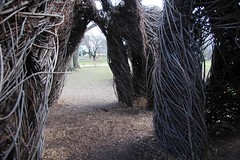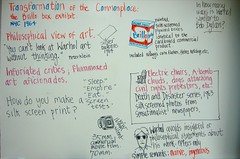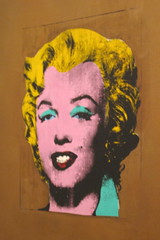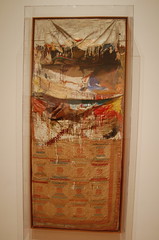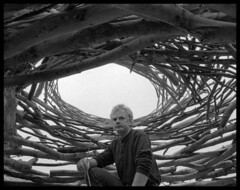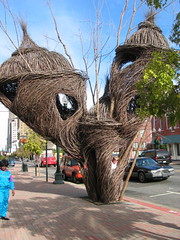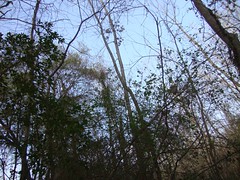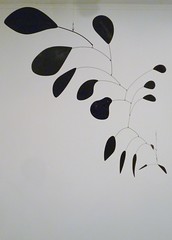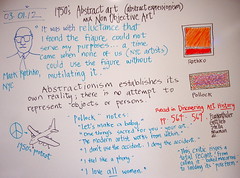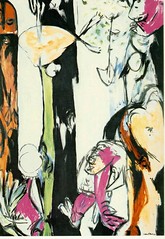Warhol's silver wigs quiz
1. Warhol: "Making ____ is art." a) provocation b) commonplace c) celebrity d) money.
2. Warhol's city of origin: a) Manhattan b) Philadelphia c) Pittsburgh d) NYC.
3. The musical group taken under the aegis of Warhol: a) Ramones b) Heroin c) Sweet Jane d) Velvet Underground.
4. Means that the person does not give a damn: a) insouciant b) naive c) flummoxed d) ingenuous.
5. Art from urban debris: a) Pollock b) Warhol c) Rauschenburg d) Patrick Dougherty.
6. Stephen Koch notes the philosophical nature of Warhol's work when he asserts, "You cannot look at Warhol's art without __ ." a) feeling b) thinking c) being mystified d) being offended.
7. Warhol's filmmaking wrecked the accepted rules of cinema, especially in the static, 8-hour movie called a) Eat b) Sleep c) Empire d) Screen Test.
8. In the mid-1960's Warhol created a sensation via the Brillo Box series of sculptures. They were made of a) cardboard b) plywood c) paper d) silk screens.
9. The Exploding Plastic Inevitable was a) performance art b) another name for the Factory c) a movie featuring Edie Sedgwick d) silver pillows.
Thursday, March 22, 2012
Your 15 minutes of fame, as predicted by Warhol . . .
15 minutes of fame is short-lived, often ephemeral, media publicity or celebrity of an individual or phenomenon. The expression was coined by Andy Warhol, who said in 1968 that "In the future, everyone will be world-famous for 15 minutes."
The phenomenon is often used in reference to figures in the entertainment industry or other areas of popular culture, such as reality TV and YouTube. It is believed that the statement was an adaptation of a theory of Marshall McLuhan, says Wikipedia.
Becoming bored with continually being asked about this particular statement, Warhol attempted to confuse interviewers by changing the statement variously to "In the future 15 people will be famous" and "In 15 minutes everybody will be famous."
The age of reality television has seen the comment wryly updated as: "In the future, everyone will be obscure for 15 minutes."[13] The British artist Banksy has made a sculpture of a TV that has, written on its screen, "In the future, everyone will be anonymous for 15 minutes."
A more recent adaptation of Warhol's quip, possibly prompted by the rise of online social networking, blogging, and similar online phenomena, is the claim that "In the future, everyone will be famous to fifteen people" or, in some renditions, "On the Web, everyone will be famous to fifteen people".
The phenomenon is often used in reference to figures in the entertainment industry or other areas of popular culture, such as reality TV and YouTube. It is believed that the statement was an adaptation of a theory of Marshall McLuhan, says Wikipedia.
Becoming bored with continually being asked about this particular statement, Warhol attempted to confuse interviewers by changing the statement variously to "In the future 15 people will be famous" and "In 15 minutes everybody will be famous."
The age of reality television has seen the comment wryly updated as: "In the future, everyone will be obscure for 15 minutes."[13] The British artist Banksy has made a sculpture of a TV that has, written on its screen, "In the future, everyone will be anonymous for 15 minutes."
A more recent adaptation of Warhol's quip, possibly prompted by the rise of online social networking, blogging, and similar online phenomena, is the claim that "In the future, everyone will be famous to fifteen people" or, in some renditions, "On the Web, everyone will be famous to fifteen people".
Wednesday, March 21, 2012
Rocks and sticks quiz: Patrick Dougherty's "Natural History"
Rocks and sticks quiz
1. Sculpture from woven saplings. a) Andy Goldsworthy b) Patrick Dougherty c) Clyde Connell.
2. Sculpture from flower blossoms: ___ art. a) ephemeral b) mortal c) Abstract d) expressionistic
3. Sculpture from balanced rocks. a) Andy Goldsworthy b) Patrick Dougherty c) Clyde Connell.
4. Three-dimensional, site-specific work of art that attempts to transform perception of a space: __ art. a) conceptual b) installation c) abstract d) philosophical.
5. Sculptor notable for creating a type of kinetic sculpture that takes advantage of the principle of equilibrium. a) Alexander Calder b) Salvador Dali c) Robert Rauschenburg d) Jackson Pollock.
6. Sculptor who made art from brown paper, newspaper, rattan, cypress, discarded farm implements and rocks. a) Andy Goldsworthy b) Patrick Dougherty c) Clyde Connell.
7. "The White Paintings:" a) Alexander Calder b) Salvador Dali c) Robert Rauschenburg d) Jackson Pollock.
1. Sculpture from woven saplings. a) Andy Goldsworthy b) Patrick Dougherty c) Clyde Connell.
2. Sculpture from flower blossoms: ___ art. a) ephemeral b) mortal c) Abstract d) expressionistic
3. Sculpture from balanced rocks. a) Andy Goldsworthy b) Patrick Dougherty c) Clyde Connell.
4. Three-dimensional, site-specific work of art that attempts to transform perception of a space: __ art. a) conceptual b) installation c) abstract d) philosophical.
5. Sculptor notable for creating a type of kinetic sculpture that takes advantage of the principle of equilibrium. a) Alexander Calder b) Salvador Dali c) Robert Rauschenburg d) Jackson Pollock.
6. Sculptor who made art from brown paper, newspaper, rattan, cypress, discarded farm implements and rocks. a) Andy Goldsworthy b) Patrick Dougherty c) Clyde Connell.
7. "The White Paintings:" a) Alexander Calder b) Salvador Dali c) Robert Rauschenburg d) Jackson Pollock.
Monday, March 19, 2012
Warhol / Brillo Boxes and Screen tests
Warhol is the philosophical artist whose work was to "transfigure the commonplace."
"You can't look at a Warhol without Thinking." Stephen Koch.
He infuriated critics and flummoxed aficionados with series such as the Brillo Boxes.
When he moved into film, he exasperated film lovers by re-defining the medium. Landmark art films included 8 hours of the Empire St Bldg in "Empire," and nearly an hour of a fellow eating a mushroom in "Eat."
His 5-minute film portraits called Screen Tests remain classics.
He answered interviewers and critics with naive, brainless answers, thus retaining the mystery in his work.
While people in the orbit of the factory were leading debauched lives, Warhol pursued his work and held the center.
"You can't look at a Warhol without Thinking." Stephen Koch.
He infuriated critics and flummoxed aficionados with series such as the Brillo Boxes.
When he moved into film, he exasperated film lovers by re-defining the medium. Landmark art films included 8 hours of the Empire St Bldg in "Empire," and nearly an hour of a fellow eating a mushroom in "Eat."
His 5-minute film portraits called Screen Tests remain classics.
He answered interviewers and critics with naive, brainless answers, thus retaining the mystery in his work.
While people in the orbit of the factory were leading debauched lives, Warhol pursued his work and held the center.
Friday, March 16, 2012
How are Robert Rauschenburg and Andy Warhol alike and how are they different?
Alike: witty, conceptual, use of clippings and newspaper photos, silk screened images.
Different: Rauschenburg was more apt to be collaborative and to use collage as a theme.
Different: Rauschenburg was more apt to be collaborative and to use collage as a theme.
Thursday, March 15, 2012
Wednesday, March 14, 2012
At the intersection of fine arts and business: Andy Warhol
Warhol was first a successful illustrator. When he entered the world of fine arts paintings, he brought unabashed commerce to the game.
At his death the Warhol estate was some $600 million, says "Warhol, the Complete Picture."
- illustrator
- silk screen reproductions
- appropriator (plucking photos and clippings from mass media)
- filmmaker
- publisher
- market maven
- celeb monger
- event producer
- music producer - the Velvet Underground
- artist as celeb
- salon / studio as center for dubious behavior at The Factory
- pop artist and provocateur
At his death the Warhol estate was some $600 million, says "Warhol, the Complete Picture."
- illustrator
- silk screen reproductions
- appropriator (plucking photos and clippings from mass media)
- filmmaker
- publisher
- market maven
- celeb monger
- event producer
- music producer - the Velvet Underground
- artist as celeb
- salon / studio as center for dubious behavior at The Factory
- pop artist and provocateur
Tuesday, March 13, 2012
Andy Warhol Project: Portrait of a classmate in the mode of Gold Marilyn
In this project the idea is to imitate Warhol's technique and style as expressed in the 1962 "Gold Marilyn."
- source material is a newspaper photo in b/w - or you may shoot a portrait of someone and print it in b/w.
- enlarged to Fill Out - to the edges - an 8 1/2 X 11 sheet of paper.
- add pink to the face.
- adding the color accents on lips, eyes, hair and collar.
- white teeth.
- gold background.
- Print your name in the lower right corner - of the front - so I can score it easily.
Due Wed, Mar 21. 15 pts.
See a khan academy video here.
- source material is a newspaper photo in b/w - or you may shoot a portrait of someone and print it in b/w.
- enlarged to Fill Out - to the edges - an 8 1/2 X 11 sheet of paper.
- add pink to the face.
- adding the color accents on lips, eyes, hair and collar.
- white teeth.
- gold background.
- Print your name in the lower right corner - of the front - so I can score it easily.
Due Wed, Mar 21. 15 pts.
See a khan academy video here.
Rauschenburg urban debris collage project
Next class we will scour the edge of Viking Dr for street detritus. Pieces of plastic, metal, glass, fabric, pebbles.
Glued down to a page atop clippings and paint, it will be an homage to the Robert Rauschenburg "Combines" of the 1950s, in which non-traditional materials and objects were employed in innovative combinations.
Rauschenberg picked up trash, says Wikipedia, and found objects that interested him on the streets of New York City and brought these back to his studio where they could become integrated into his work. He claimed he "wanted something other than what I could make myself and I wanted to use the surprise and the collectiveness and the generosity of finding surprises."
The artist continued collaging newsprint and photographic materials in his work and the impetus to combine both painting materials and everyday objects such as clothing, urban debris, and taxidermied animals such as in Monogram[34] continued throughout his artistic life.
Rauschenburg's wit was part of his artistic style. In 1953 he erased a drawing by Willem de Kooning, which he obtained from his colleague for the express purpose of erasing it as an artistic statement. The result is titled Erased de Kooning Drawing.
Also in 1953 Rauschenberg created his "White Paintings," in the tradition of monochromatic painting, whose purpose was to reduce painting to its most essential nature, and to subsequently lead to the possibility of pure experience.
In 1961 Rauschenberg took a step in what could be considered the opposite direction by championing the role of creator in creating art's meaning. Rauschenberg was invited to participate in an exhibition at the Galerie Iris Clert, where artists were to create and display a portrait of the owner, Iris Clert. Rauschenberg's submission consisted of a telegram sent to the gallery declaring "This is a portrait of Iris Clert if I say so."
He was from Texas but was a Pop art lion of the New York art world from the 1960's to the end of his life in 2008.
Glued down to a page atop clippings and paint, it will be an homage to the Robert Rauschenburg "Combines" of the 1950s, in which non-traditional materials and objects were employed in innovative combinations.
Rauschenberg picked up trash, says Wikipedia, and found objects that interested him on the streets of New York City and brought these back to his studio where they could become integrated into his work. He claimed he "wanted something other than what I could make myself and I wanted to use the surprise and the collectiveness and the generosity of finding surprises."
The artist continued collaging newsprint and photographic materials in his work and the impetus to combine both painting materials and everyday objects such as clothing, urban debris, and taxidermied animals such as in Monogram[34] continued throughout his artistic life.
Rauschenburg's wit was part of his artistic style. In 1953 he erased a drawing by Willem de Kooning, which he obtained from his colleague for the express purpose of erasing it as an artistic statement. The result is titled Erased de Kooning Drawing.
Also in 1953 Rauschenberg created his "White Paintings," in the tradition of monochromatic painting, whose purpose was to reduce painting to its most essential nature, and to subsequently lead to the possibility of pure experience.
In 1961 Rauschenberg took a step in what could be considered the opposite direction by championing the role of creator in creating art's meaning. Rauschenberg was invited to participate in an exhibition at the Galerie Iris Clert, where artists were to create and display a portrait of the owner, Iris Clert. Rauschenberg's submission consisted of a telegram sent to the gallery declaring "This is a portrait of Iris Clert if I say so."
He was from Texas but was a Pop art lion of the New York art world from the 1960's to the end of his life in 2008.
Sunday, March 11, 2012
Please browse the Khan Academy.org for math, science, art history and more
(CBS News) Sal Khan is a math, science, and history teacher to millions of students, yet none have ever seen his face.
Khan is the voice and brains behind Khan Academy, a free online tutoring site that may have gotten your kid out of an algebra bind with its educational how-to videos.
Now Khan Academy is going global. Backed by Google, Gates, and other Internet powerhouses, Sal Khan wants to change education worldwide, and his approach is already being tested in some American schools.
http://www.khanacademy.org/#browse
Khan is the voice and brains behind Khan Academy, a free online tutoring site that may have gotten your kid out of an algebra bind with its educational how-to videos.
Now Khan Academy is going global. Backed by Google, Gates, and other Internet powerhouses, Sal Khan wants to change education worldwide, and his approach is already being tested in some American schools.
http://www.khanacademy.org/#browse
Friday, March 9, 2012
Environmental sculptor: the British-but-global Andy Goldsworthy
Andy Goldsworthy, OBE (born 1956) is a British sculptor, photographer and environmentalist producing site-specific sculpture and land art situated in natural and urban settings, says Wikipedia. He lives and works in Scotland.
The materials used include brightly-coloured flowers, icicles, leaves, mud, pinecones, snow, stone, twigs, and thorns.
He said, "I think it's incredibly brave to be working with flowers and leaves and petals. But I have to: I can't edit the materials I work with. My remit is to work with nature as a whole."[7]
Goldsworthy is considered the founder of modern rock balancing. For his ephemeral works, Goldsworthy often uses only his bare hands, teeth, and found tools to prepare and arrange the materials.
Photography plays a crucial role in his art due to its ephemeral and transient state. According to Goldsworthy, "Each work grows, stays, decays – integral parts of a cycle which the photograph shows at its heights, marking the moment when the work is most alive. There is an intensity about a work at its peak that I hope is expressed in the image. Process and decay are implicit."[8]
The materials used include brightly-coloured flowers, icicles, leaves, mud, pinecones, snow, stone, twigs, and thorns.
He said, "I think it's incredibly brave to be working with flowers and leaves and petals. But I have to: I can't edit the materials I work with. My remit is to work with nature as a whole."[7]
Goldsworthy is considered the founder of modern rock balancing. For his ephemeral works, Goldsworthy often uses only his bare hands, teeth, and found tools to prepare and arrange the materials.
Photography plays a crucial role in his art due to its ephemeral and transient state. According to Goldsworthy, "Each work grows, stays, decays – integral parts of a cycle which the photograph shows at its heights, marking the moment when the work is most alive. There is an intensity about a work at its peak that I hope is expressed in the image. Process and decay are implicit."[8]
Wednesday, March 7, 2012
Installation art: a bizarre tree grew up on Texas St via artist PatrickDougherty
Combining his carpentry skills with his love of nature, Patrick Dougherty began to learn about primitive techniques of building and to experiment with tree saplings as construction material. Beginning about 1980 with small works, fashioned in his backyard, he quickly moved from single pieces on conventional pedestals to monumental site-specific installations that require sticks by the truckload. To date he has built over two hundred such massive sculptures all over the world, says stickwork.net.
His home base is his handmade house of log in Chapel Hill, NC where he lives with his wife Linda and son Sam.
Installation art at Artspace Shreveport: Patrick Dougherty sculpture
Award-winning sculptor Patrick Dougherty called this installation "Arcadia," which means "a region offering rural simplicity and contentment."
He built it from saplings with the help of volunteers on Texas St, Shreveport, in 2004. It was a commission from the Shreveport Regional Arts Council.
Installation art describes an artistic genre of three-dimensional works that are often site-specific and designed to transform the perception of a space, says Wikipedia.
Generally, the term is applied to interior spaces, whereas exterior interventions are often called Land art; however, the boundaries between these terms overlap.
Installation art can be either temporary or permanent. Installation artworks have been constructed in exhibition spaces such as museums and galleries, as well as public and private spaces.
He built it from saplings with the help of volunteers on Texas St, Shreveport, in 2004. It was a commission from the Shreveport Regional Arts Council.
Installation art describes an artistic genre of three-dimensional works that are often site-specific and designed to transform the perception of a space, says Wikipedia.
Generally, the term is applied to interior spaces, whereas exterior interventions are often called Land art; however, the boundaries between these terms overlap.
Installation art can be either temporary or permanent. Installation artworks have been constructed in exhibition spaces such as museums and galleries, as well as public and private spaces.
Monday, March 5, 2012
Learning from artist Andy Goldsworthy: picking up twigs, etc, on a Coates Bluff Nature Trail walk
Be ready to walk on Coates Bluff Nature Trail on Wed as we gather twigs, etc, for art projects.
A project that's in imitation of the award-winning artist Andy Goldsworthy.
Also, allow me to introduce an additional environmental artist, also an amazing and award-winning sculptor; he is Patrick Dougherty, aka stick man.
A project that's in imitation of the award-winning artist Andy Goldsworthy.
Also, allow me to introduce an additional environmental artist, also an amazing and award-winning sculptor; he is Patrick Dougherty, aka stick man.
Friday, March 2, 2012
After bloody goring, Spanish bullfighter Juan José Padilla returns tothe arena
Check this NY Times story for an update on Picasso's favorite sport.
The artist who developed the mobile: American sculptor Alexander Calder
Alexander Calder (1898 – 1976) was an American sculptor and artist most famous for inventing mobile sculptures.
In addition to mobile and stable sculpture, says Wikipedia, Alexander Calder also created paintings, lithographs, toys, tapestry, jewelry and household objects.
In addition to mobile and stable sculpture, says Wikipedia, Alexander Calder also created paintings, lithographs, toys, tapestry, jewelry and household objects.
Thursday, March 1, 2012
Pollock Jackson near the end of his career: "Easter Totem"
As a culminating activity, students will compsoe 3 questions about the movie - or about art and life - and briefly describe 3 scenes from the movie. You may state whether you found the scene affecting or not.
Be sure it's legible.
"I owe that woman something. I'd be dead without her," was what Pollock says - wearing a boat-neck shirt - near the end of the eponymous movie bio.
The couple were living largely separate lives near the end. Pollock was no longer the hot painter. His friend, the NY Times art critic, pointed out that Pollock had enjoyed 10 years at the top.
Pollock is presented as perhaps the first American art superstar - glorified by Life Magazine and the subject of a film. The movie implied that he never got over it.
He died in a self-destructive rage. His girlfriend's girlfriend died in the same wreck.
Be sure it's legible.
"I owe that woman something. I'd be dead without her," was what Pollock says - wearing a boat-neck shirt - near the end of the eponymous movie bio.
The couple were living largely separate lives near the end. Pollock was no longer the hot painter. His friend, the NY Times art critic, pointed out that Pollock had enjoyed 10 years at the top.
Pollock is presented as perhaps the first American art superstar - glorified by Life Magazine and the subject of a film. The movie implied that he never got over it.
He died in a self-destructive rage. His girlfriend's girlfriend died in the same wreck.
Subscribe to:
Posts (Atom)


